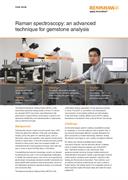Tato stránka není v současné době k dispozici ve vašem jazyce. Automatizovaný překlad můžete zobrazit pomocí nástroje Google Translate. Neodpovídáme za poskytování této služby a výsledky překladu jsme nekontrolovali.
Potřebujete-li další pomoc, kontaktujte nás.
Raman spectroscopy: an advanced technique for gemstone analysis
The National Gemstone Testing Centre (NGTC), is the authoritative gemstone testing facility in China. For almost two decades NGTC have been using Renishaw's high performance confocal Raman microscopes to perform non-destructive identification and characterisation of gemstones, such as diamond and jade.
Background
Following the period of rapid economic growth since 1978, China has gained the attention of the gem and jewellery industry across the globe. For centuries gems, such as diamonds, rubies and sapphires, have played a pivotal part in society. In recent years, in line with Chinese economic growth, demand for these luxury items has increased rapidly. It is estimated that the current gemstone industry retail sales per year in China is about CNY500 billion (~$72 billion).
Counterfeiting has become increasingly common as demand for gemstones has risen. It can be exceptionally challenging to identify the authentic gems, even for the most experienced gemmologist. Increasingly advanced scientific instruments are being utilised within gemstone testing laboratories, driven by this heightened demand for gemstone testing, by businesses and consumers alike.
The National Gemstone Testing Centre (NGTC) is the authoritative testing organisation for the gemstone industry in China. The NGTC is committed to the development and promotion of new testing methods and technologies. A key instrument routinely utilised across NGTC's testing laboratories is Renishaw's inVia confocal Raman microscope.
Challenge
As the technologies used for creating counterfeits increase in complexity, so must the methods used to identify them. It has become increasingly difficult to visually distinguish the gems processed by modern technology; therefore, testing laboratories have begun to use a variety of analytical methods.
Mr. Zhang Jian, National Qualified Gems Quality Assurance Inspector, and the technical director of Beijing Gems & Jewelry Research Institute, part of the NGTC, said, “Gemstone testing is a very serious job. Each gemstone sample should go through multiple testing and characterisation procedures. Initially, a gemmologist conducts routine testing, including visual inspection, refractive index testing and fluorescence observation. Then methods, such as infrared and Raman spectroscopy, are used to perform further testing. The testing result is not acceptable until two to three inspectors repeat the above steps and make the same judgement.”
Solution
The NGTC has been using Renishaw's Raman microscopes since 1999, when Renishaw launched its products in China. They are now used across NGTC's laboratories in Beijing, Shanghai and Shenzhen. Renishaw Raman spectrometers can certify gem authenticity and determine whether gems are natural, synthetic or treated. A key advantage is the ability to perform non-destructive analysis of gemstones.
With unparalleled flexibility, Renishaw's inVia confocal Raman microscope is the ideal instrument for gemstone analysis. inVia can be fitted with two sample stages that are easy to switch between. A standard small microscope sample stage, for routine sample testing, and an open microscope sample stage, suitable for bulk sample testing, such as large volumes of raw gemstones. inVia can be configured with multiple laser options, allowing analysis of a vast range of gemstones. NGTC Beijing headquarters inVia is equipped with 325 nm, 473 nm, 532 nm, 785 nm and 830 nm lasers, currently the fullest configuration in the domestic gemstone industry.
Diamond identification is NGTC's largest testing business and Raman spectroscopy has a vital role to play. Currently artificial diamonds are most commonly synthesised by methods such as chemical vapor deposition (CVD) and high temperature and pressure (HTHP). Using inVia, CVD produced diamond can be identified with photoluminescence, characterised by two 737 nm lines.
Renishaw's Raman spectrometers can also be used for multi-component sample testing and characterisation, for example on jades. Often jade, feldspar and other components coexist within a sample, with a relatively fine structure. In such cases, components can only be identified and characterised using Raman mapping.
In addition, Renishaw's inVia is used in crystal defect research, gem inclusion analysis and determining whether gem fissures have been filled. inVia is an ideal tool for the analysis of beryl, in which there are many solid, liquid and gas phase inclusions. A combined spectrum of these inclusions and beryl base is obtained, from which the constituents can be identified from a database of liquid and gas reference spectra.
Results
Using Renishaw Raman spectrometers NGTC can certify gemstone authenticity and determine whether they are natural, synthetic or treated. inVia can identify solid, liquid and gas inclusions, even when they are deep inside the gem. Mr. Zhang Jian is very optimistic about Raman spectrometry's prospects in gemstone investigation. He commented, "From the application point of view, there is no doubt about Raman spectrometry's role in the gemstone testing industry. But each kind of gemstone testing instrument has its own merits and demerits; it is impossible to use only one tool to solve all gemstone sample identification issues. Therefore, the right tools must be selected based on the testing sample characteristic in the testing process." Raman technology is continuously advancing and with the increasing testing demands and the development of testing organizations, there is great potential for Raman spectroscopy in the gemstone industry.
This case study is edited based on the article “Laser Raman Spectrometry: Advanced Weapons for Gemstone Identification” released 18 July, 2016 on www.instrument.com.cn Author: Ye Jian



